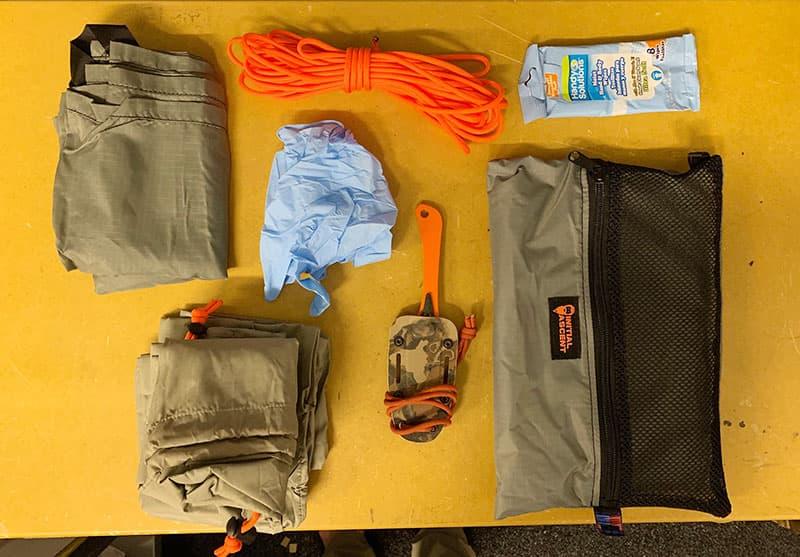
Deer Field Dressing Kit: The Essentials Explained
Dennis Stokes
When I was a kid growing up in the Panhandle of Florida, I was your typical country boy who loved to fish, hunt, and trap. Surprisingly, my parents never once took me camping so I was only left with my imagination and outdoor magazines about gear and equipment for adventures.
One of my favorite nouns to this day is “kit”. Having a kit meant that everything you needed to be prepared for a certain task is neatly organized within one central location or container. My first kit was a First Aid Kit around age 7. I was prepared for any medical emergency as I would spend, what seemed like hours, taking everything out and reorganizing for the next adventure.
Today, it’s no different. I still get excited about kits. I’m constantly tweaking each one so that there’s no fluff, lack of efficiency, or extra unnecessary weight.
My favorite kit is my Deer Field Dressing Kit or Kill Kit. This will be essential when you’ve made a well-placed, ethical shot on that buck, and he expires before he hits the ground. All of the required equipment should be kept in one organizational gear bag (i.e. IA Pack Sacks). See below:

Below, I detail a few of the most important items in the deer field dressing kit.
There are a couple of choices in knife styles here that are most common:
First, fixed blade knives are very strong, very sharp, and can easily pry under joints and bones quite aggressively. You don’t ever have to worry about the blade or knife breaking while in the heat of field dressing your animal. You also work with the same blade every time without having to replace it. On the other hand, you must sharpen this blade. Often, you’ll have to sharpen the blade in the field which requires some skill as well as carrying a separate sharpener. This adds bulk and weight to your kit.
The second style is a replaceable blade knife. These are typically very lightweight and come with multiple removable, ultra-sharp surgical blades. These easily slice through whatever you want to cut with precision and make quick work of any animal. You also never have to sharpen these. When they become dull, you simply replace the blade with a new one. However, most will break if you try to pry anything. It’s happened to me numerous times in the field usually when I get in a hurry. You must be careful when replacing blades as well when you have blood and animal fat on your hands. A multitool comes in handy for replacing blades.
I always like to carry 25-50’ of paracord because you never know when you’ll need it. You can use it for all kinds of things, but let’s stick to how it relates to the process of field dressing. There are two main reasons for needing paracord when breaking down an animal: using it to help hold legs open while field dressing solo and using it to help hang the quarters from a tree limb or meatpole. Some game bags now have drawstrings made of paracord for the latter use. One can also use it to attach game bags of meat to horses or a bike for transport out of the backcountry.
This is one of the most important items in the Deer Field Dressing Kit. There are many types of game bags out there and I won’t talk about them all. In fact, I’m going to talk about what I like to use in a good game bag. This is one of the items on which I don’t mind spending money. First, I want my game bags to be large enough to handle bone-in quarters. Most of the time, I leave the meat on the bone. Next, they must be reusable and washable. I don’t want to worry about buying new throwaways all the time. The seams need to be bonded or surged for strength and durability. Last but not least, they should be breathable. They must be able to keep dirt and bugs off, but they absolutely must be breathable. We sure don’t want to work that hard harvesting, caring for, and packing out an animal to have the meat compromised by a poor selection of game bags. Some bags even have antimicrobial properties.
Before you go out on your next hunt, do yourself a favor and make sure you’ve gotten your Deer Field Dressing Kit or Kill Kit in order. It’s so much easier if it’s all in one location in a gear bag (Pack Sack) and placed in your pack where it can be easily found.
One of my favorite nouns to this day is “kit”. Having a kit meant that everything you needed to be prepared for a certain task is neatly organized within one central location or container. My first kit was a First Aid Kit around age 7. I was prepared for any medical emergency as I would spend, what seemed like hours, taking everything out and reorganizing for the next adventure.
Today, it’s no different. I still get excited about kits. I’m constantly tweaking each one so that there’s no fluff, lack of efficiency, or extra unnecessary weight.
My favorite kit is my Deer Field Dressing Kit or Kill Kit. This will be essential when you’ve made a well-placed, ethical shot on that buck, and he expires before he hits the ground. All of the required equipment should be kept in one organizational gear bag (i.e. IA Pack Sacks). See below:

- Tags/License (should always be with the kill kit or in a specific single pocket of your pack)
- Sharp Knife (either fixed or replaceable blades)
- 25 ft of paracord
- Rubber gloves (for keeping hands clean)
- Good quality, light-weight game bags (5)
- A contractor-sized garbage bag or synthetic drop cloth
- Wet wipes
Below, I detail a few of the most important items in the deer field dressing kit.
Knife
There are a couple of choices in knife styles here that are most common:
- Fixed Blade
- Replaceable Blade.
First, fixed blade knives are very strong, very sharp, and can easily pry under joints and bones quite aggressively. You don’t ever have to worry about the blade or knife breaking while in the heat of field dressing your animal. You also work with the same blade every time without having to replace it. On the other hand, you must sharpen this blade. Often, you’ll have to sharpen the blade in the field which requires some skill as well as carrying a separate sharpener. This adds bulk and weight to your kit.
The second style is a replaceable blade knife. These are typically very lightweight and come with multiple removable, ultra-sharp surgical blades. These easily slice through whatever you want to cut with precision and make quick work of any animal. You also never have to sharpen these. When they become dull, you simply replace the blade with a new one. However, most will break if you try to pry anything. It’s happened to me numerous times in the field usually when I get in a hurry. You must be careful when replacing blades as well when you have blood and animal fat on your hands. A multitool comes in handy for replacing blades.
Paracord
I always like to carry 25-50’ of paracord because you never know when you’ll need it. You can use it for all kinds of things, but let’s stick to how it relates to the process of field dressing. There are two main reasons for needing paracord when breaking down an animal: using it to help hold legs open while field dressing solo and using it to help hang the quarters from a tree limb or meatpole. Some game bags now have drawstrings made of paracord for the latter use. One can also use it to attach game bags of meat to horses or a bike for transport out of the backcountry.
Game Bags
This is one of the most important items in the Deer Field Dressing Kit. There are many types of game bags out there and I won’t talk about them all. In fact, I’m going to talk about what I like to use in a good game bag. This is one of the items on which I don’t mind spending money. First, I want my game bags to be large enough to handle bone-in quarters. Most of the time, I leave the meat on the bone. Next, they must be reusable and washable. I don’t want to worry about buying new throwaways all the time. The seams need to be bonded or surged for strength and durability. Last but not least, they should be breathable. They must be able to keep dirt and bugs off, but they absolutely must be breathable. We sure don’t want to work that hard harvesting, caring for, and packing out an animal to have the meat compromised by a poor selection of game bags. Some bags even have antimicrobial properties.
Before you go out on your next hunt, do yourself a favor and make sure you’ve gotten your Deer Field Dressing Kit or Kill Kit in order. It’s so much easier if it’s all in one location in a gear bag (Pack Sack) and placed in your pack where it can be easily found.

1 comment
Good Article! Hunting elk in grizzly country, here is my (solo hunter) backpack list for field dressing game (Whitetail, Mule Deer & Elk): 5 or 6 game bags ( incase I debone the meat); two butcher knives & one fillet knife; Knife sharpener; 50 feet of Paracord (for use in breaking down a large animal and hanging meat if needed); painter’s drop cloth (for laying out game parts as they are separated); rubber gloves; Wet wipes; bear caliber revolver for unexpected/unwanted company; Hawk Crawler game cart (for hauling out the meat); 2 head lamps for low light work (with extra batteries); FIRST AID KIT. If I’m hunting within 2 miles from the truck, I’ll come back for the game cart after downing an animal. If I go deeper into the backcountry, I’ll take the game cart along with me. I just leave my game cart with my backpack close by when I do a final stock for a shot.